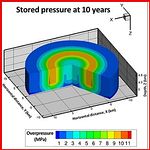科學家正在開發一種新型態的地熱電廠。美國明尼蘇達大學、俄亥俄州立大學和勞倫斯利弗莫爾國家實驗室合作,將多餘的二氧化碳鎖在地下,並把這些液態二氧化碳用作地熱電廠的補充液,可提高地熱電廠10倍的發電輸出。
傳統的地熱發電廠是利用地底熱水的熱能產生電力,再將冷水釋放回地下。科學家嘗試將部分熱水以二氧化碳或另外一種液體,或兩者的混合液取代,使吸熱效果更好。電腦模擬顯示,新方法比傳統的地熱發電效率至少高出一倍。
在相對低溫低壓時,二氧化碳變成「超臨界」的狀態。這樣的狀態下,二氧化碳密度有如液體,但是又能如氣體般輕易流動。
將二氧化碳注射進充滿不可飲用鹽水的沉積盆地,以一層不透水岩層封蓋住。超臨界狀態的二氧化碳會浮在鹽水上。隨著越來越多二氧化碳被注射進來,鹽水逐漸被二氧化碳取代。液態二氧化碳的高流動性使之能快速運輸其承載的熱能,通過高熱的地質層,到達地表的生產井,釋放出熱能和壓力,驅動渦輪產生電能。
接著冷卻膨脹的二氧化碳和從化石燃料電廠新捕捉來的二氧化碳,再被打回地底,重新開始整個過程。「因此過程中沒有二氧化碳進入大氣,事實上所有的二氧化碳最終都被鎖在地下。」Saar說。
 這個以同心循環多種液體的新方法,是以明尼蘇達大學Martin Saar等人的研究為基礎。12月13日在舊金山舉辦的美國地球物理聯盟會議上,研究團隊發表了新地熱電廠設計的擴充版本,並以電腦動畫解釋能源技術如何解決氣候變遷問題。
這個以同心循環多種液體的新方法,是以明尼蘇達大學Martin Saar等人的研究為基礎。12月13日在舊金山舉辦的美國地球物理聯盟會議上,研究團隊發表了新地熱電廠設計的擴充版本,並以電腦動畫解釋能源技術如何解決氣候變遷問題。
擴充版的電廠設計有一系列地下水平井同心環,酷似傳統地熱電廠和大強子對撞機的結合。同心環內,二氧化碳、氮氣和水分別將熱能從地下帶到地表,轉動渦輪產生電力。
地下的地熱層可儲存熱能,將二氧化碳和氮氣加壓,並且在電力需求最大時將熱能釋放到地表的電廠。新電廠也能在電力需求低或可再生電力供應充足時暫停自地下擷取熱能。
電腦模擬顯示,一個位於地下3英哩深、寬10英哩的水平井同心環,能產生近5億瓦的電力,等同於一個中型火力發電廠,也是美國一般地熱電廠約輸出3千8百萬瓦電力的10倍以上。電腦模擬也顯示,這樣的發電廠每年可封存約1千5百萬噸的二氧化碳,等同於3個中型火力發電廠產生的二氧化碳量。
Researchers are developing a new kind of geothermal power plant that will lock away unwanted carbon dioxide, CO2, underground – and use the greenhouse gas in liquid form as a tool to boost electric power generation 10-fold in geothermal power plants.
Teams of researchers at the University of Minnesota, Ohio State University and Lawrence Livermore National Laboratory are collaborating on using CO2 in its liquid form as a supplemental fluid in geothermal power plants.
Typical geothermal power plants tap into hot water that is deep under ground, pull the heat off the hot water, use that heat to generate electricity, and then return the cooler water back to the deep subsurface. Here the water is partly replaced with CO2 or another fluid – or a combination of fluids that extract heat more efficiently than water alone.
This approach – using concentric rings that circulate multiple fluids – builds upon the idea to use CO2 originally developed by Martin Saar and others at the University of Minnesota, and can be at least twice as efficient as conventional geothermal approaches, computer simulations show.
At relatively low temperatures and pressures CO2 becomes “supercritical,” a phase in which it has the density of a liquid but flows as easily as a gas.
“CO2 would go supercritical during injection, after it gets about 800 meters deep,” says Saar. “It would stay supercritical underground.”
The CO2 would be injected into a sedimentary basin filled with impotable salty water and capped by a layer of impermeable rock. The supercritical CO2 would float on top of the brine and displace it as more CO2 was added. Its high mobility would allow it to rapidly transport the heat it picks up, through the hot geologic formation and up a production well to the surface. There, the release of its heat and pressure would drive a turbine to generate electricity.
The cooled and expanded CO2 would then be pumped back into the ground, along with fresh CO2 captured at the fossil fuel power plant, to repeat the cycle.
“As a result, no CO2 is released to the atmosphere, and, in fact, all of the CO2 is eventually, permanently stored underground,” explained Saar.
At the American Geophysical Union meeting on December 13 in San Francisco, the research team debuted an expanded version of the design, along with a computer animated movie to explain the role that energy technologies can have in addressing climate change.
The expanded power plant design resembles a cross between a typical geothermal power plant and the Large Hadron Collider: It features a series of concentric rings of horizontal wells deep underground.
Inside those rings, CO2, nitrogen and water circulate separately to draw heat from below ground up to the surface, where the heat can be used to turn turbines and generate electricity.
The underground geothermal formation could store hot, pressurized CO2 and nitrogen, and release the heat to the surface power plant when electricity demand is greatest.
The plant could also suspend heat extraction from the subsurface during times of low power demand, or when there is already a surplus of renewable power on the grid.
In computer simulations, a 10-mile-wide system of concentric rings of horizontal wells situated about three miles below ground produced as much as half a gigawatt of electrical power – an amount comparable to a medium-sized coal-fired power plant – and 10 times more than the 38 megawatts produced by the average geothermal plant in the United States.
The simulations also revealed that a plant of this design might sequester as much as 15 million tons of CO2 per year, which is roughly equivalent to the amount produced by three medium-sized coal-fired power plants in that time.
※ 全文及圖片詳見:ENS








